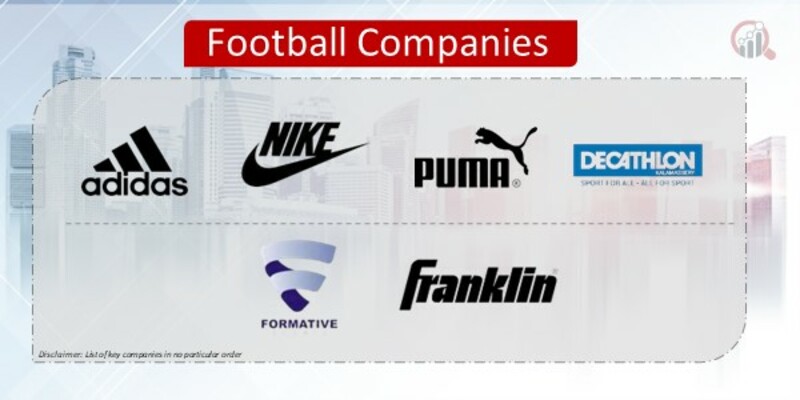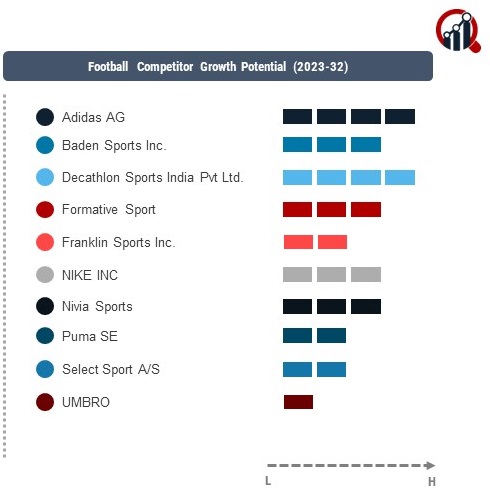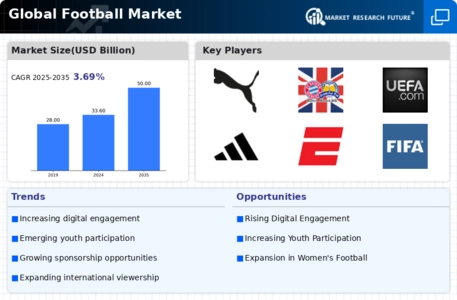Top Industry Leaders in the Football Market
 The competitive landscape of the football market is marked by key players implementing various strategies to capitalize on the global popularity of the sport and its associated products and services. These players significantly influence industry dynamics, and their strategies collectively shape the overall competitive scenario.
The competitive landscape of the football market is marked by key players implementing various strategies to capitalize on the global popularity of the sport and its associated products and services. These players significantly influence industry dynamics, and their strategies collectively shape the overall competitive scenario.
Key Players:
Adidas AG
Baden Sports Inc.
Decathlon Sports India Pvt Ltd. (Decathlon S.A.)
Formative Sport
Franklin Sports Inc.
Nike Inc.
Nivia Sports
Puma SE (Artemis S.A)
Select Sport A/S
UMBRO (Iconix Brand Group)
Wilson Sporting Goods Company (Amer Sports)
Strategies Adopted:
The football market adopt various strategies to address the evolving preferences of football enthusiasts and stay ahead in a highly competitive industry. A common approach involves continuous innovation in product design and technology, with companies introducing new football boots, apparel, and equipment featuring the latest advancements in materials and performance-enhancing features. Additionally, strategic partnerships with football clubs, national teams, and high-profile athletes contribute to expanding market reach and ensuring that football products are associated with top-tier endorsements.
Efficient supply chain management, aggressive marketing campaigns during major football events, and targeted digital advertising are critical elements of the strategies adopted by key players. These strategies enable companies to offer a wide range of products, engage with consumers globally, and maintain a competitive edge in a market driven by rapid product turnover and changing fashion trends.
Market Share Analysis:
The football industry is influenced by several factors. Brand loyalty, product performance, pricing, and visibility through sponsorships play pivotal roles in consumers' purchasing decisions. Companies that invest in understanding and addressing the specific needs of football players and fans gain a competitive edge. Furthermore, effective marketing, strong distribution channels, and responsive customer service contribute significantly to brand loyalty and market share.
News & Emerging Companies:
The football market has witnessed the emergence of new and specialized companies responding to the demand for niche football products and services. Emerging players, such as Future1, have entered the market with a focus on technology-driven football training equipment and wearables. These new entrants often bring fresh perspectives to player development and fan engagement, contributing to the diversification of available products and enhancing overall market competitiveness.
Industry Trends:
The football industry include a growing emphasis on sustainability, digital fan engagement, and advancements in sports technology. Companies are investing in research and development to introduce sustainable football gear, using recycled materials and eco-friendly manufacturing processes. Additionally, there is a noticeable trend of companies enhancing their digital presence, utilizing social media platforms, and leveraging data analytics for targeted marketing and personalized fan experiences.
Furthermore, the industry has witnessed increased investments in sports technology. Companies are exploring innovations such as smart footballs with embedded sensors, virtual reality (VR) training simulations, and data analytics for performance optimization. This move not only addresses the evolving needs of tech-savvy players and coaches but also positions these companies strategically in the competitive landscape of sports technology.
Competitive Scenario:
The football market is marked by intense competition among key players, driven by the global passion for the sport and the associated lifestyle. Companies are engaged in a continuous race to offer not only high-performance products but also solutions that align with broader trends of sustainability, innovation, and fan engagement.
The market is also influenced by factors such as major football events, the influence of social media in shaping brand perception, and the ongoing global movement toward sports as a form of entertainment and cultural expression. Manufacturers must adapt swiftly to market demands, ensuring that their football products not only meet the highest performance standards but also resonate with the diverse and passionate football community.
Recent Development
The football market witnessed a notable development with key players focusing on advanced technology integration and sustainability practices. Several major companies announced significant investments in smart football technology, introducing products with embedded sensors and connectivity features that provide real-time data on ball performance and player statistics. These innovations were aimed at enhancing player training, performance analysis, and fan engagement through interactive experiences.
Moreover, there was a discernible trend of companies prioritizing sustainability in manufacturing. Major players announced initiatives to use eco-friendly materials, reduce carbon footprints, and implement circular economy practices in the production of football gear. This move not only resonated with environmentally conscious consumers but also positioned these companies as leaders in responsible manufacturing within the football industry.










